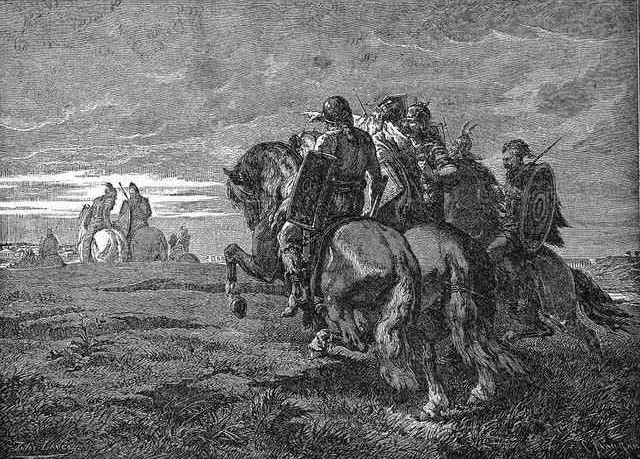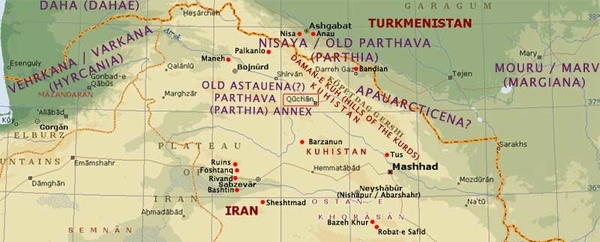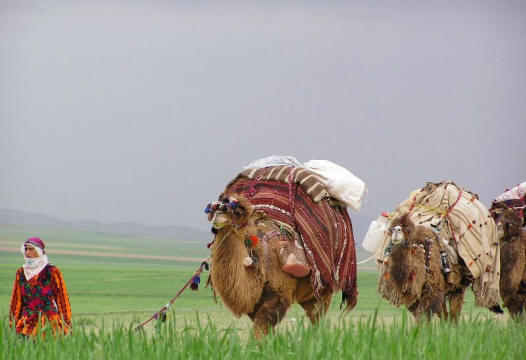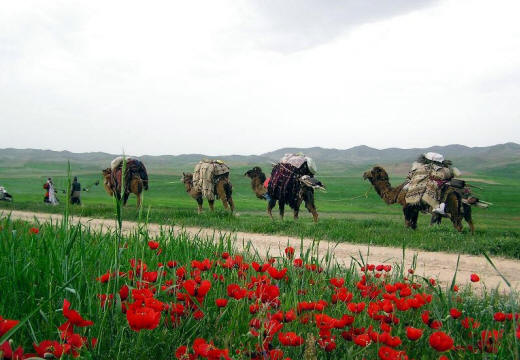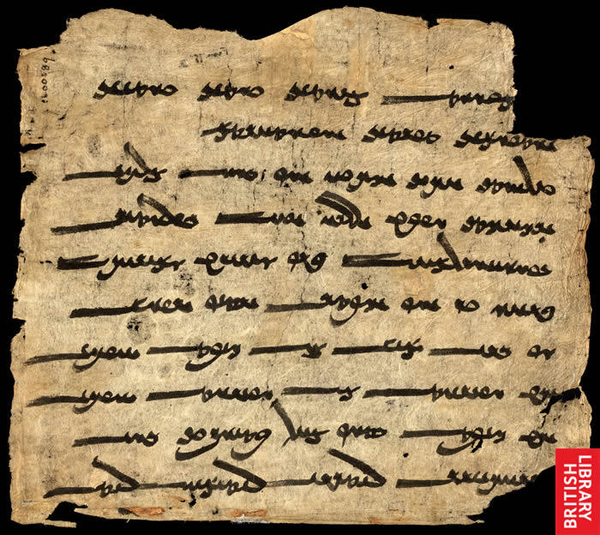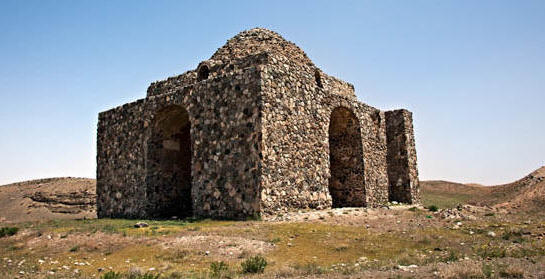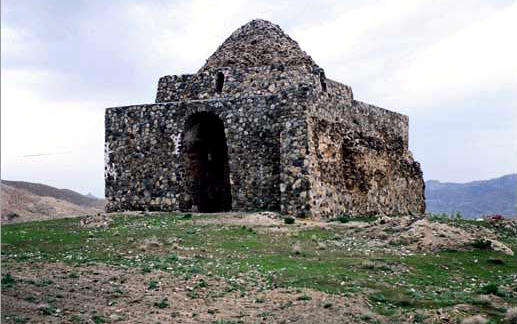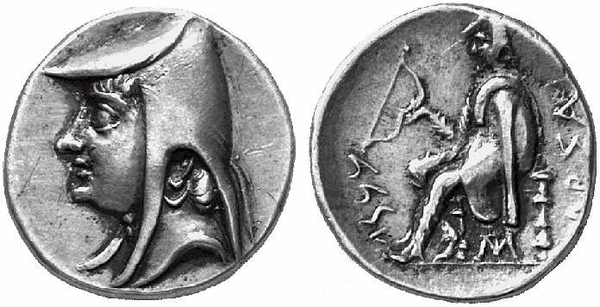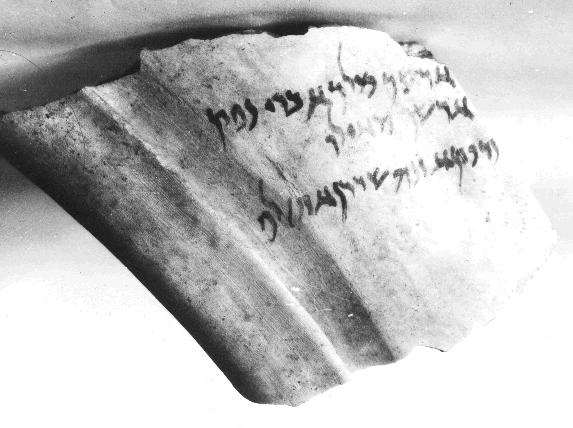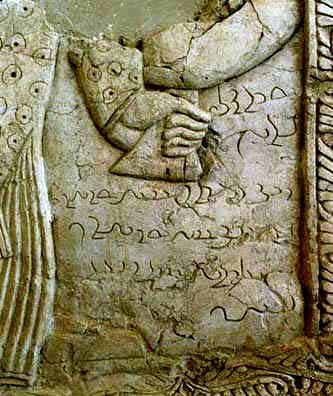
| PARTHIA Preface :
Parthian leaders in battle gear from Ridpath's Universal History (1899). NYPL Digital Gallery The Parthians under the leadership of Arshak I (Arsaces I) liberated Iran-Shahr from Macedonian domination following Alexander's conquest in 330 BCE. Arshak's first significant victory over the Macedonian Seleucids was in 247 BCE. Arshak and his successors re-consolidated the Iranian-Aryan lands and re-constituted the federation of Iranian kingdoms.
According to the Middle Persian (Pahlavi) Karnamak kar, the Book of Deeds, "there were in the territory of Iran two hundred and forty princes" at the end of Macedonian rule. To appreciate the size and scope of the federation, think of it as a country with 240 states.
In re-constituting the federation of Iranian kingdoms, the Parthava (Parthian) kings became King-of-Kings of Iran-Shahr.
The Parthian kings also undertook the second re-compilation of the Avesta, the Zoroastrian scriptures. The scriptures and the priests who had preserved them primarily as an oral tradition, had been dispersed under Macedonian rule.
Origins of the Parthava (Parthians) :
Map of Ancient Parthava (Parthia) & Modern Khorasan, Iran. Base map credit: Microsoft Encarta Summary: Parthia as a nation was already in existence around 1000 BCE. It was a successor nation to Nisaya, the fifth nation mentioned in the Avesta's, the Zoroastrian scriptures', book of Vendidad. As a result, it is sometimes known was Parthaunisa. The Parthians are thought to be Dahi-Saka Aryans, (Dahae in western literature) a branch of the Iranian-Aryan family that had its origins in an area around the upper reaches of the Syr Darya (Jaxartes) river. The Dahi migrated 1,500 km westward towards land around the southeast Caspian coast and the Kopet Dag mountains. The Parthava may have in this manner shared origins with the ancestors of legendary Rustam of Sistan. The strongmen of both groups are called pahlavans, a word related to Pahlavi, a later form of Parthava. The reason of the migration of these Saka groups out of the original Saka homeland appears to have been internal conflict. The Saka pahlavans were protectors of Iran-Shahr and the Iranian throne, a role they would fulfil very well when they liberated Iran-Shahr from Macedonian rule.
References: According to Marcus Justinus (3rd cent. CE) jus (41.1) before the Parthava (Parthians) settled in the area around Nisa (Nisaim), they lived in the land of the Saka* from where they were exiled and forced to leave because of discord. He states, "The Parthians, in whose hands the empire of the east now is, having divided the world, as it were, with the Romans, were originally exiles from the land of the Saka*." Justinus continues, "During the time of the Assyrians and Medes, they were the most obscure of all the people of the east."** "...they were continually harassed by severe wars with the Saka and other neighbouring nations, and pressed with various other formidable contests." "The Parthians, being forced to quit the land of the Saka by discord at home, gradually settled in the deserts betwixt Hyrcania (Varkana, Gorgan), the Dahae (Dahistan), the Arei (Aria), the Sparni and Marsiani. (Hi domesticis seditionibus Scythia pulsi solitudines inter Hyrcaniam et Dahas et Areos et Sparnos et Margianos furtim occupauere.)"
*Justinus uses Scythia. While several writers incorrectly use the group names Saka and Scythian interchangeably, in his Histories, Herodotus differentiates between western and eastern 'Scythians', correctly naming the so-called eastern Scythians as Sacae (Saka). We feel using the term Scythians in place of Saka can lead to confusion about the origins of the Eastern Aryan Saka groups such as the Dahi and the Parthava.
**Justinus informs us that Parthava had already been formed by the time of the Assyrians (c 2000-600 BCE) and Medes (c 800-550 BCE). Diodorus (1st c. BCE), states that the Parthians had "passed from the dominion of the Assyrians to that of the Medes... to a similar position under the Persians." We see the first historical mention around 500 BCE, of Parthava in the rock inscriptions of Darius the Great at Behistun. Parthava itself was a successor kingdom to ancient Nisaya, the fifth nation mentioned in the Zoroastrian scriptures book of Vendidad (see below).
The original home of the Parthians that Justinus speaks of was probably the Saka lands also inhabited by the Dahi, i.e. the land around the upper to mid Syr Darya or Jaxartes river. According to Justinus, internal discord between the Saka forced the Parthians to leave their original homeland and migrate to new lands. The Dahi did the same and both migrated nearly 1500 km westwards towards the Caspian Sea. [For a further discussion, please see our Dahi page as well as our page on the Saka.]
Northern Khorasani nomads. Image Credit: Khoosheh-Chin
Strabo str (c 63/64 BCE - 24 CE) in 11.9.2 of his Geography states that Arshak (Arsaces) was not native to Parthia but a member of the Parni Dahi, a Saka group: "Arsaces, a Sacae, (with the Parni, called nomads, a tribe of the Dahæ, who live on the banks of the Ochus***), invaded Parthia, and made himself master of it. At first both Arsaces and his successors were weakened by maintaining wars with those who had been deprived of their territory. Afterwards they became so powerful... ." In 11.9.3, "They say that the Dahæ Parni were an emigrant tribe from the Dahæ... ."
[***There is a great deal of confusion regarding the modern identification of the river Ochus and with Strabo's account in this section. Based on Strabo, some have it as the river Murgab (there are several by this name. One flows out of north-eastern Afghanistan into Turkmenistan. Others have it as the Oxus (Amu Darya) and yet others as a tributary of the Oxus, now the river Pandj bordering Tajikistan and Afghanistan. All this means the region of ancient Balkh (Bactria). However, given the various classical references to the Dahae and that of Strabo himself (see our page on the Saka), it would seem he means the upper reaches of the river Jaxartes or Syr Darya (cf. Tashkent & Fergana valley), the original homeland of the Dahi (Dahae). Strabo used several sources and sometimes these sources gave him conflicting information. Strabo's uses a far more accurate source for his descriptions of the Däae (Dahi) and Sacae in 11.8.1-8 (see our Saka page).]
Relationship Between the Parthava (Parthians) and Other Saka :
The Names Parthava, Parthia and Pahlavi :
Parthia is the Latin-English version of Parthava. The Old Persian word Parthav / Parthava evolved into Pahlav / Pahlavi. Pahlavan meaning strongman and champion is an associated word.
In his epic the Shahnameh, the poet Ferdowsi calls the eponymous founder of the dynasty of Parthava emperor-kings, Arshak (Arsaces), by the name Ashk. Ferdowsi also calls the dynasty that Arshak / Ashk founded as Ashkanian dynasty. The name Ashk carries with it the virtues of being wise, pure and holy.
A seventh century BCE Assyrian texts mention a country named Partakka or Partukka and some authors feel this is the first historical mention of Parthava / Parthia as a vassal state of Mada (Medes). There is nothing further than the words being homonyms to further substantiate this hypothesis.
Parthava (Parthians) & Zoroastrianism
Earliest surviving manuscript of an Avesta segment, the Ashem Vohu prayer written in a script derived from Parthavi-Pahlavi. Found in China. British Library Or. 8212/84 (Ch.00289) In our preface above, we noted that the second compilation of the Avesta took place during the Parthavi reign (cf. our page on the Zoroastrian Scriptures, the Avesta. The first compilation had taken place during the Achaemenian dynasty). The Macedonians had burnt the royal Achaemenian libraries, instituted by kings such as Cyrus the Great and Darius the Great, and which had contained the precious complete first compilation copies of the written Avesta. The Macedonians also destroyed the main fire temples and killed their priests who preserved the oral tradition of memorizing the scriptures.
Following
their overthrow of Macedonian rule, the Parthians promulgated the
compilation of the scattered remnants of the Avesta. The Middle
Persian Pahlavi texts, the Dinkard (edition Madon) 412.5-11, translated
by R. C. Zaehner in Zurvan, a Zoroastrian Dilemma, reads :
The Parthian recompiled Avesta has not survived. However, in all likelihood it formed the basis of the Sassanian Avesta.
Fire Temples of Parthava :
Everlasting
or eternal fires are maintained and 'guarded' in a fire temple,
a Zoroastrian fire temple, and Asaak is the town mentioned by Isidorus
where a temple housing the eternal fire resides. This singular mention
of an eternal fire in all of Isidorus' account is fairly significant
and speaks to the importance of the fire maintained at Asaak. It
appears likely that Arshak chose to have his coronation performed
in Asaak since it had a very important fire temple, a significant
reassertion of Iranian-Aryan heritage in the Aryan lands. [We
note here the closeness of the name of the city Asaak and the name
Ferdowsi gives to Arshak: Ashk.]
Bazeh Khur Fire Temple, Khorasan. One of the oldest Chahar-Taqi temples from the Parthian era 247 BCE-224 CE. 80 km s of Mashhad & at Robat Sefid Village's edge Bazeh Khur Fire Temple, Khorasan. One of the oldest Chahar-Taqi temples dating to the Parthian era (247 BCE-224 CE). 80 km s of Mashhad & at Robat Sefid Village's edge. Image credit: Ali Majdar at Flickr
Another image of the Bazeh Khur fire temple. Image credit: www.itto.org Zoroastrian
Practices During Parthavi (Parthian) Times :
According to Marcus Justinus jus in 41.3, "Their (Parthian) general mode of sepulchre is dilaniation (tearing in pieces) by birds or dogs; the bare bones they at last bury in the ground." This describes the Zoroastrian funerary practices of the Parthava: exposure of dead bodies to birds, and the subsequent burial of the bones stripped of flesh in an ossuary for burial.
Justinus adds, "principal veneration is paid to rivers" an aspect of Zoroastrian veneration for the environment.
Parthava (Parthians) Saviours of Iran-Shahr & the Iranian-Aryan
Family :
In the pahlavan tradition, the Parthavi (Parthians) were indeed the saviours of Iranshahr, the Iranian-Aryan nation. During the invasion of Iranshahr, they together with the rest of the Aryan kingdoms were dealt a severe blow. They were down but they were not out. The rose, fought back, fought valiantly and expelled the aggressor. There is no telling what would have happened to Iranshahr or Zoroastrianism had the Parthavi (Parthians) not liberated and reconsolidated the Iranian lands.
It is no accident that after the Islamic invasion, Zoroastrians fleeing before the Arab hordes sought refugee in the kuhistans of Khorasan - the mountains of old Parthava.
Parthavi Names :
Language: Parthian & Pahlavi
Silver Drachma 4 gram from reign of Arsaces I 247-211 BCE. Obverse: Head wearing a wearing bashlyk.
Ostraca Documents from Old Nisa. Image credit: Vladimir A. Livshits The Iranian-Aryan dialect that the Parthava spoke, Parthavi, became Pahlavi. Pahlavi in turn came to be known as Parsik, the forerunner of Parsi / (sic) Farsi i.e. modern Persian today. It is that authentic Persian, Parsi, that Ferdowsi sought to revive. Ferdowsi ancestral home was Tus, a village in the foothills of Parthavi heartland.
In further detail, the development of Parthavi into Parsi (Persian) is as follows :
The Parthian current at the time of the Arshak (Arsacid) dynasty (c 247 BCE-229 CE) was what we now call Arshaki Parthavi (Arsacid Parthian) - sometimes known as Arshaki (Arsacid) Pahlavi or Pahlavanik. Pahlavi as a name is the modern derivative of Parthavi. The evolution of the word Parthavi happened in the same way, we are told, that the name Mithra evolved to Meher. Pahlavanik was the predecessor language to Sassanian Pahlavi, the language used during the Sassanian dynasty (c 229 to 650 CE). Pahlavanik, also known as Parsik, is more commonly known as Middle Persian or Pahlavi after the script used in its writing. Parsik eventually became modern Parsi (Persian), misnamed by the Arabs as Farsi since the Arabic alphabet did not have the letter 'p'.
Written Language or Script :
The coins are silver drachma (sic - the Greek term. We do not know the Parthavi word) minted by the founder of the Parthavi imperial dynasty, Arshak I (247-211 BCE).
Ostraca is the plural form of ostracon, a piece of recycled broken pottery shards used for writing notes. Two thousand years ago, broken pottery was often used as a cheap and enduring writing surface. The earliest Parthavi ostraca found have been at the excavations at Nisa / Mithradatkird, in today's Turkmenistan.
Pahlavi inscription from Bandian. Image credit: CAIS Nisa is located at the foot of the northern Kopet Dag mountain slopes. It was a major Parthava city, an administrative centre, and possibly one of the Parthavi (Parthian) capitals. Some were found in a part of the complex that are thought to be the Treasury's cellar. Others were found in a wine store. The shards with brief notes/ records are reported to be in the 'thousands' though we know of only a few examples. Several ostraca that are fully dated bear the names and genealogy of the immediate family of a king. One ostraca has been translated by Vladimir A. Livshits as "Arshak, the king, son of grandson (i.e. great grandson) of Arshak. Accounted this offering - 2000 e(phas) of barley".
While the coin and ostraca are the earliest surviving examples of written Parthavi, we cannot assume that the Parthavi script was introduced only as late as the during the Arsshak Parthava (Arsacid Parthisn) era. Scripts do not appear overnight. They take generations to develop and we do not have the first known use of Parthavi script. Becoming literate in a script takes learning by an entire group of people in order for the script to become an accepted means of communication and record keeping. The Parthavi script would have developed at a considerably earlier time than the Arsacid era. For the written language to have developed during foreign Macedonian / Seleucid domination - which imposed the Greek language and script - would have been highly improbable. It is more probable that written Parthavi was in use during the Hakhmanishi (Achaemenian) era (c 675-330 BCE) when the so-called Aramaic script was used for the related Hakhmanishi (Achaemenian) language.
References :
Jus. Marcus Justinus (3rd cent. CE) in Epitome of the Philippic History of Pompeius Trogus, translated by the Rev. John Selby Watson (London, 1853).
Isi. Parthian Stations (Mansiones Parthicae) by Isidorus Characenus (Isidore of Charax) was written sometime between 29 and 1 BCE. It lists all the supply stations, that is caravanserais maintained by the Parthavi (Parthian) Government for the convenience of merchants travelling along the caravan trail from Antioch, today a Mediterranean port in the southwest corner of Turkey, to the borders of India. With liberation from Macedonian rule, the Iranian-Aryans once again asserted control and facilitated trade along the Silk Roads.
Str. Strabo (ca. 63/64 BCE - 24 CE) Geography, translated by H. C. Hamilton, Esq. and W. Falconer, M.A.
Pol. Polybius (c 200-118 BCE) The Histories, was a Greek historian of the Hellenistic Period whose book covered history of the period of 220-146 BCE
Additional reading: » The Seven Great Monarchies, Vol. 6, Parthia by George Rawlinson
Source :
http://www.heritageinstitute.com/ |
